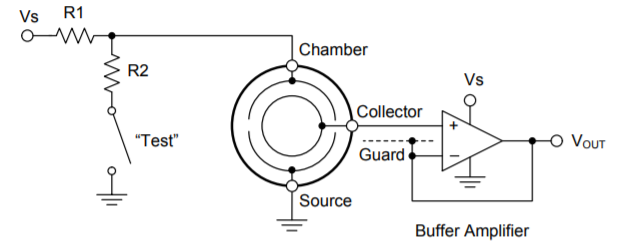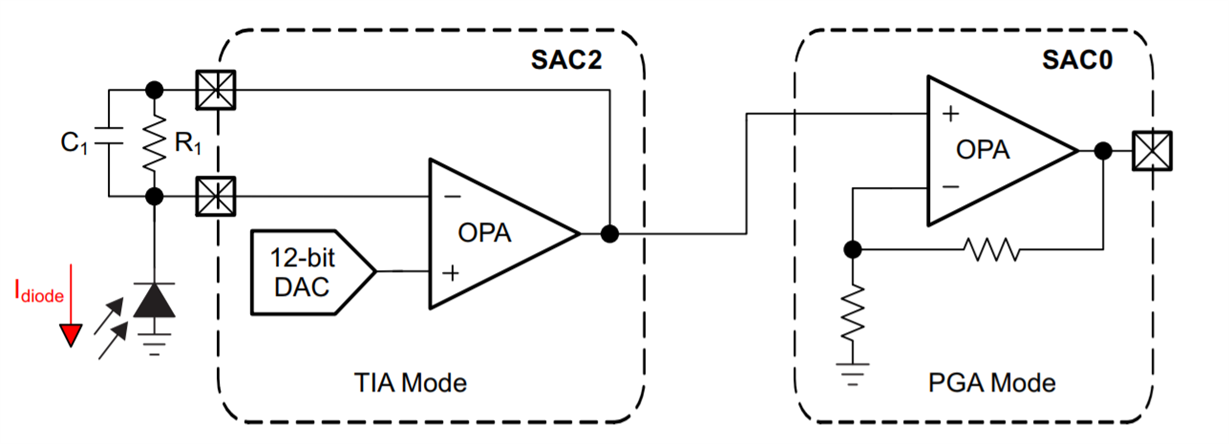SSZT648 august 2018 MSP430FR2311 , MSP430FR2355
The first smoke detection devices were invented in the 1890s, including an electric fire alarm and a heat detector. These inventions improved over the years, leading to more sophisticated designs like ionization and optical smoke detectors.

Thanks to modern-day electronics, designing these types of smoke detectors is simple, robust and cost-effective. When smoke detectors are AC-powered, they typically have 9V backup batteries. Thus, they have to be designed for the absolute lowest power consumption to reduce the size of the AC/DC power supply and increase battery life during backup.
Ionization smoke detectors work by using a radiation source (usually Americium-241) to ionize the air. When air enters the smoke detector, the radiation source splits the air molecules into positive and negative ions. The ionization chamber in the smoke detector includes positive and negative electrodes, which are the chamber and the source shown in Figure 1.
The positive ions are attracted to the negatively charged source, and the negative ions are attracted to the positively charged chamber. This attraction creates a voltage on the collector plate, also shown in Figure 1. Smoke particles entering the smoke detector interfere with the ionization and cause a voltage drop on the collector plate. This voltage drop is buffered as VOUT, which the detector monitors as an indication of smoke in the chamber. VOUT can be fed into a comparator or an analog-to-digital converter (ADC).
 Figure 1 Ionization Smoke Detector
Working Principle
Figure 1 Ionization Smoke Detector
Working PrincipleAn optical smoke detector uses an infrared (IR) light-emitting diode (LED) and an IR receiver to detect smoke. The IR receiver detects light from the IR LED and outputs a certain amount of current based on how much IR light it detects. This current feeds into a transimpedance amplifier (shown in Figure 2) to convert the current into a voltage. The voltage feeds into a second-stage amplifier to amplify the signal to a level appropriate for monitoring. When smoke enters the IR chamber, it scatters the IR light and interferes with IR receiver detection. This causes the IR receiver to alter its current output, and ultimately the voltage at the output of the second-stage operational amplifier (op amp). Like an ionization smoke detector, either a comparator or an ADC can monitor this voltage change to detect smoke.
 Figure 2 Optical Smoke Detector Working
Principle
Figure 2 Optical Smoke Detector Working
PrincipleAs you can see, op amps are a necessity when it comes to designing these types of smoke detectors. However, these external op amps increase the bill of materials (BOM), eat up printed circuit board (PCB) space and introduce additional costs. TI has released a new MSP430™ microcontroller (MCU) that has integrated analog peripherals and helps relieve this burden.
The MSP430FR2355 features a peripheral with four configurable signal-chain modules called the Smart Analog Combo. Each module includes a flexible and configurable 12-bit digital-to-analog converter (DAC) and an op amp. There are many ways to configure each module, including general-purpose mode, buffer mode, noninverting programmable gain amplifier (PGA) mode, inverting PGA mode and DAC mode. This peripheral helps reduce additional components in a design, and will also help save on overall component costs while increasing robustness.
You can use the MSP430FR2355 MCU to design your next smoke detector. The extended temperature range of this device (-40°C to 105°C) is a match for the high-temperature environments smoke detectors may find themselves in. If you are designing an ionization smoke detector, you can configure a Smart Analog Combo in a buffer configuration like that shown in Figure 1.
If you are designing an optical smoke detector, you can configure two Smart Analog Combo modules into the configuration shown in Figure 3 – the first stage as a transimpedance amplifier (TIA mode) and the second stage as a gain stage (PGA mode). The Smart Analog Combo supports a picoampere-level low-leakage input that will improve the accuracy of current measurements, which will be beneficial in smoke detector designs.
 Figure 3 Using Smart Analog Combo
Modules for an Optical Smoke Detector
Figure 3 Using Smart Analog Combo
Modules for an Optical Smoke DetectorTo further enhance your smoke detector design, it’s possible to use the Smart Analog Combo for both the ionization and optical approaches. You can implement both designs on one MCU (two modules for the optical circuit and one module for the ionization circuit) and still have a module to spare. If you want to enhance an optical detector design, you can incorporate two different IR emitters with different wavelengths. Using all four modules (two for each IR circuit) will improve measurement accuracy and help avoid false alarms. As with all of our MSP430 devices, the MSP430FR2355 is optimized for low power.
For more information about how to use Smart Analog Combo modules in your design, see the application report, “How to Use the Smart Analog Combo in MSP430™ MCUs.”
Additional Resources
- Read the FR2355 smoke detector AppNote.
- Download the “MSP430FR2355 LaunchPad™ Development Kit User’s Guide.”
-
Read the white paper, “Smart Analog Combo Enables Tomorrow’s MCU-Based Sensing and Measurement Applications.”
-
Check out the “MSP430FR2311 IR Reflection-Sensing Subsystem Design Guide.”
-
Learn “How to Use the Integrated Operational Amplifiers on the MSP430FR2311.”